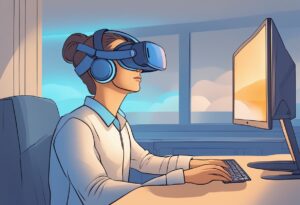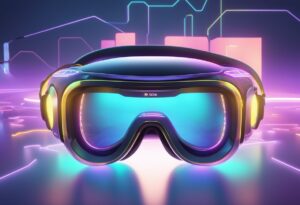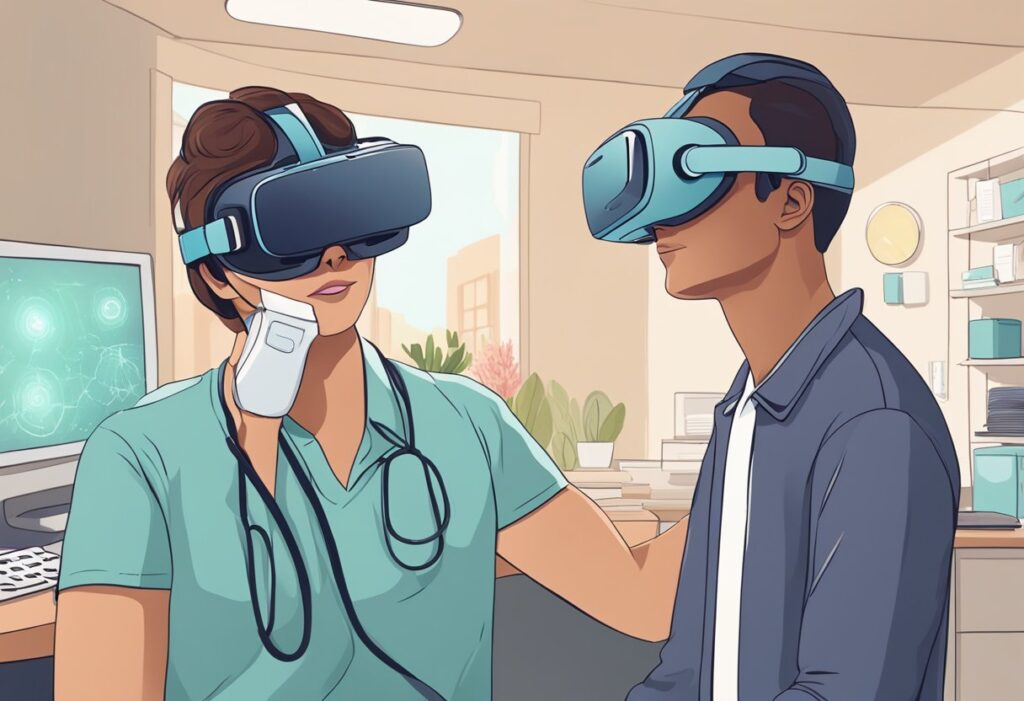Virtual reality (VR) is an immersive technology that has gained popularity in recent years. However, concerns have been raised about its impact on eye health. Some people worry that VR headsets may cause eye strain, fatigue, and other eye problems. In this article, we will explore the question, “Is VR bad for your eyes?” and provide an overview of the current research on the topic.
Understanding VR and Eye Health
Virtual reality (VR) technology has become increasingly popular in recent years, but there is still much to learn about how it affects eye health. The American Academy of Ophthalmology explains that staring for too long at a VR screen can lead to eye strain or fatigue.
This is because VR alters the depth perception of the eyes, which can cause motion sickness and blurred vision. VR users tend to blink less, causing the front surface of the eye to dry out and feel fatigued.
Potential Risks for Children and Adults
While there is no reliable evidence that VR headsets cause permanent deterioration in eyesight in children or adults, it is important to be aware of potential risks. The Canadian Association of Optometrists warns that prolonged use of VR headsets can lead to eye strain, eye discomfort, eye fatigue, and blurred vision. Children and teenagers are particularly susceptible to these symptoms, as their eyes are still developing.
The Role of Manufacturers and Safety Guidelines
Manufacturers of VR headsets have a responsibility to ensure that their products are safe for use. Calibration is important to ensure that the user’s eyes are not strained, and safety guidelines should be followed to prevent motion sickness and other symptoms. It is recommended that users take regular breaks and limit their use of VR headsets to 20-minute intervals to prevent eye strain and fatigue.
While there are potential risks associated with using VR headsets, these can be minimized by following safety guidelines and taking regular breaks. It is important for manufacturers to continue to research the effects of VR on eye health and to develop products that are safe for use by all ages.
Common Visual Effects of VR Usage
Short-Term Visual Symptoms
VR headsets can cause short-term visual symptoms such as eye fatigue, eye discomfort, and blurred vision. This is because VR screens emit blue light, which can strain the eyes and cause discomfort. Wearing a VR headset for an extended period can cause double vision, headaches, and dizziness. To reduce the risk of these symptoms, users should take frequent breaks and limit their VR usage to short periods.
Long-Term Eye Concerns
While there is no evidence to suggest that VR headsets cause long-term eye damage, some experts have expressed concern about the potential for vision deterioration with prolonged use. The American Academy of Ophthalmology recommends that users take frequent breaks and limit their VR usage to avoid any potential long-term eye concerns.
Digital Eye Strain and VR
Digital eye strain is a common condition that affects people who spend a lot of time looking at digital screens. VR usage is no exception, and users may experience eye strain, dry eyes, and discomfort. To reduce the risk of digital eye strain, users should take frequent breaks, adjust the brightness of their VR screen, and ensure that their headset is properly calibrated to reduce eye strain.
While VR headsets can cause short-term visual symptoms and digital eye strain, there is no evidence to suggest that they cause long-term eye damage. Users should take frequent breaks and limit their VR usage to avoid any potential eye concerns.

Physiological Responses to VR
Motion Sickness and VR
One common physiological response to VR is motion sickness. This occurs when the visual perception of motion does not match the physical movement of the body. The brain is unable to reconcile these conflicting signals, leading to symptoms such as dizziness, nausea, and discomfort.
Visually induced motion sickness (VIMS) can occur even in individuals who do not typically experience motion sickness in real life. However, not everyone is equally susceptible to VIMS, and some individuals may develop a tolerance to it over time.
Effects on Eye Coordination and Depth Perception
VR can also affect eye coordination and depth perception. In order to create a realistic sense of depth and immersion, VR systems often rely on stereoscopic displays, which present slightly different images to each eye. This can cause the eyes to work harder to maintain coordination, leading to eye strain and fatigue.
The use of VR can disrupt the coordination between visual perception and physical movement, leading to a loss of balance and coordination. However, these effects are generally temporary and tend to subside quickly after the user stops using the VR system.
While VR can cause some physiological responses such as motion sickness and eye strain, these effects are generally temporary and tend to subside quickly after the user stops using the VR system.
Preventative Measures and Best Practices
Importance of Regular Eye Examinations
To ensure that your eyes remain healthy while using VR headsets, it is essential to schedule regular eye examinations with an ophthalmologist or eye doctor. This will help to detect any underlying eye problems and ensure that your eyes are in good condition. Regular eye exams will also help you to determine whether you need prescription lenses for your VR headset.
VR Usage Moderation
Moderation is key when it comes to using VR headsets. Prolonged use of VR headsets can lead to eye strain, headaches, and other problems. It is recommended that users take regular breaks to rest their eyes and avoid overexertion. Users should also limit their VR usage to no more than 30 minutes at a time.
Custom Solutions for VR Headsets
Custom solutions such as VR prescription lenses and prescription lenses can help to reduce eye strain and improve the overall VR experience.
VR prescription lenses are specially designed to fit into VR headsets, providing users with a clearer and more comfortable viewing experience. Prescription lenses can also be used with VR headsets to provide a more customized viewing experience.
Preventative measures and best practices are essential to ensure that VR headsets do not harm your eyes. Regular eye examinations, moderation, and custom solutions such as VR prescription lenses and prescription lenses can help to reduce eye strain and improve the overall VR experience.
Advancements and Positive Applications of VR
Virtual reality (VR) has seen significant advancements in recent years, with a wide range of positive applications in various fields. This section will explore two such applications of VR, namely VR in education and healthcare and innovations for vision-impaired users.
VR in Education and Healthcare
VR technology has emerged as a useful tool in the field of education. It provides students with an immersive learning experience, making it easier for them to understand complex concepts. For instance, VR can be used to create virtual laboratories, where students can conduct experiments without the need for physical equipment.
Similarly, VR can be used in healthcare to simulate surgeries, allowing medical students to gain valuable experience before performing operations on real patients.
Innovations for Vision-Impaired Users
VR technology has also shown promise in helping vision-impaired people. A California-based company called IrisVision has developed a VR headset that can help people with low vision see more clearly. The headset uses corrective glasses and a VR display to magnify images, making them easier to see.
VR can be used to simulate environments for people with vision impairments, allowing them to navigate their surroundings more easily.
VR technology has made significant advancements in recent years, with a wide range of positive applications in various fields. VR in education and healthcare and innovations for vision-impaired users are just two examples of how VR can be used to improve people’s lives.

Frequently Asked Questions
What are the potential negative effects of prolonged VR headset use on vision?
Prolonged use of VR headsets can cause eye strain, dry eyes, and headaches. It can also lead to a condition called accommodative spasm, which causes the eyes to remain focused on a certain distance even when looking at objects at different distances. However, these effects are temporary and can be reduced by taking breaks and adjusting the headset’s settings.
How does VR compare to traditional screens like TVs in terms of eye health?
VR headsets are not necessarily worse for eye health than traditional screens like TVs. However, VR headsets can cause eye strain and other temporary effects if used improperly or for extended periods of time. It’s important to take breaks and adjust the headset’s settings to minimize these effects.
What steps can be taken to minimize eye strain while using VR?
To minimize eye strain while using VR, it’s important to take regular breaks, adjust the headset’s settings to your comfort level, and ensure that the headset fits properly. It’s also important to maintain proper posture and lighting conditions while using VR.
Can excessive use of VR lead to permanent vision impairment?
There is no evidence to suggest that excessive use of VR can lead to permanent vision impairment. However, prolonged use of VR headsets can cause temporary effects like eye strain and headaches.
Are there any health risks associated with daily VR usage?
There are no significant health risks associated with daily VR usage. However, it’s important to take breaks and adjust the headset’s settings to minimize temporary effects like eye strain.
How long should you use a VR headset in one session to avoid eye strain?
To avoid eye strain, it’s recommended to take breaks every 20-30 minutes while using a VR headset. It’s also important to adjust the headset’s settings to your comfort level and ensure that the headset fits properly.














